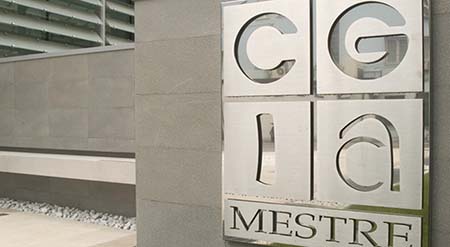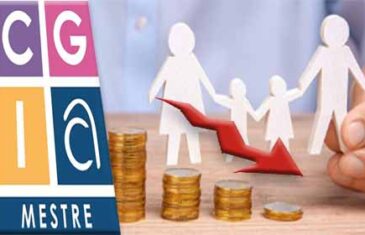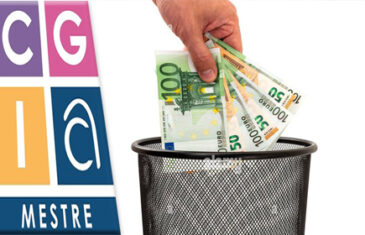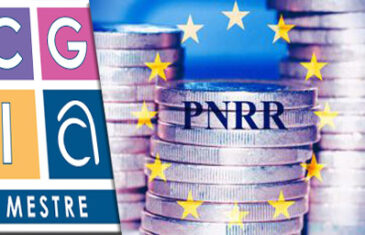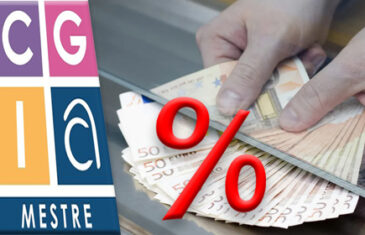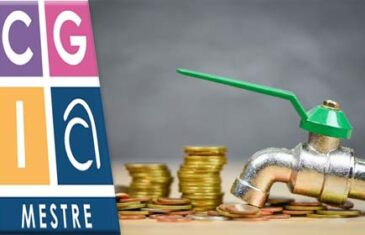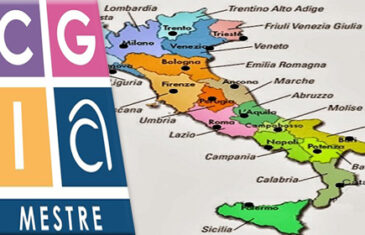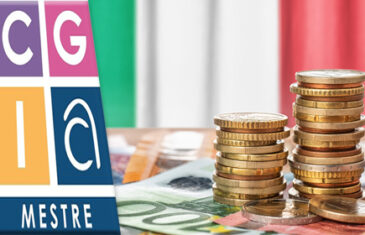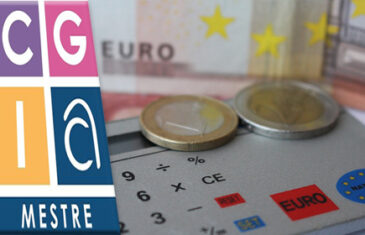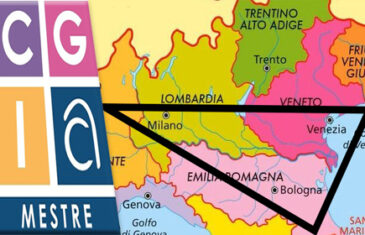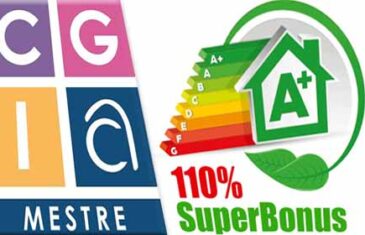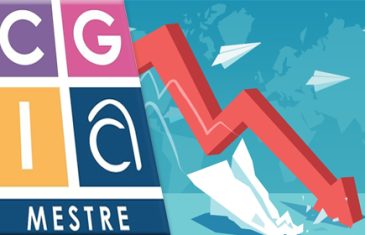The center of gravity of the Italian production system has moved to the east: Milan, Bologna and Venice on the shields. The number of heavy vehicles that speed along almost the entire A4 Milan-Venice every day is double compared to that which runs on the Turin-Milan route. Although it represents a very empirical indicator, truck traffic flows also […]
read moreSkilled workers are increasing, but we have the lowest employment rate in the Eurozone and self-employed workers are decreasing. It is a particularly positive moment for our labor market. Both for the historical record of employed people and for the increase in the number of those who have a permanent employment contract and, finally, [...]
read moreThe forecasts show us that within the next 10 years the number of people of working age (15-64 years) in Italy is destined to decrease by 3 million units (-8,1 percent). If at the beginning of 2024 this demographic cohort included just under 37,5 million units, in 2034 the same is destined [...]
read moreThe gap has also increased between the north and the south. In the three programming cycles of European cohesion policy (2000-2006, 2007-2013 and 2014-2020), Brussels invested a total of 970 billion euros. Of these, Italy received 125 billion; resources which in these 20 years have been allocated to reducing the territorial gap between [...]
read moreThe top 5 most internationalized provinces are all along the A4 motorway. Last year, Italian exports showed total stability compared to 2022. In absolute terms, sales abroad amounted to 626 billion euros. Among the 27 countries of the European Union only Germany with 1.562 billion and the Netherlands with 866 [...]
read moreIn 2022, there were 465.000 young people in Italy who left school prematurely [Italian population between 18 and 24 years old with at most a middle school diploma, who have not completed a professional training course recognized by the Region lasting more than 2 years and who does not attend school courses or […]
read moreImports could be at risk: especially from Lombardy and Veneto. Until now, the winds of war blowing in the Middle East have not yet produced particularly serious effects on our trade. In fact, between the first two months of 2023 and the same period of this year, the number of merchant ships (cargo […]
read more11,2 euros embezzled from the tax authorities for every 100 collected. The number of people arrested for criminal violations of a tax nature decreases, but the revenue recovered through the fight against tax evasion increases. Of course, there is not necessarily an inversely proportional link between these two phenomena, however it is important to point out that the fight against fiscal infidelity always produces results [...]
read moreDue to the inflation boom recorded between 2021-2023, equal to +14,2 percent, the average Italian family has spent 4.039 euros more in the last two years. If, in fact, the annual expenditure of families in current terms in 2021 amounted to 21.873 euros, in 2023 it rose to 25.913 euros (+18,5 percent). […]
read moreThere are reasonable certainties in believing that in the relationship between the State and the Italian taxpayer, the person most penalized by the "damage" caused by the dishonorable conduct of the other is not the first, but the second. Considering a whole series of caveats, which will be highlighted later in this note, the thesis of the Research Office of [...]
read moreAlthough our industry in the strict sense contributes "only" 21 percent to the national GDP, between 2007 and 2022 the real added value of Italian manufacturing activity fell by 8,4 percent, in France by 4,4, 16,4 percent, while in Germany the change was positive and even equal to +XNUMX per [...]
read moreBetween pensions, salaries, intermediate consumption, healthcare, assistance, etc., every year our country records public spending more than five times higher than the PNRR; in 2023, state expenditure will exceed, in absolute terms, one thousand billion euros, but, unlike the PNRR - which between 2021 and mid-2026 there [...]
read moreIf at a national level the ratio is now one to one, in the South, however, the overtaking has already occurred; we are talking about the comparison between the number of pensions paid and that of those employed. If in Italy the former is equal to 22.772.000 and the latter amounts to 23.099.000, in the regions of the South and […]
read moreThanks to the Municipalities' fight against tax evasion/avoidance, 2022 million euros were recovered in 6, practically 0,007 percent of the 90 billion euros that tax offenders unduly withhold every year. In 2023, in fact, the central state disbursed half, just over 3 million euros, to municipal administrations, [...]
read moreBergamo, Varese, La Spezia and Lecco are the provinces where the credit crunch for very small companies has been felt most. It is now a credit crunch: in the last year in which the data are available (August 2023 compared to the same month in 2022), live bank loans to Italian companies decreased by 7,7 percent. In […]
read moreTo the minimum wage by law, the CGIA invites the application of second level bargaining, the cut of Irpef and the renewal of contracts within the deadline. As in many European countries, even in Italy the wage differences at territorial level are important . In 2021, for example, the average annual gross salary of employed Italian workers […]
read moreA real blow. The inflation boom has also caused a strong revaluation of the severance pay (TFR) [the TFR is a remuneration element of a deferred nature which is due to the employee upon termination of the employment relationship, regardless of the type of withdrawal , and which accrues monthly. It is a […]
read moreTwo out of three ministries continue to pay their suppliers late. This bad habit that has characterized most of the Italian Public Administration (PA) for decades continued in the first two quarters of this year. Although it is still early to generalize, in the case of ministries we have confirmation that payment delays continue. […]
read moreThe paradoxes present in our labor market are evident and one of these is highlighted in this note from the CGIA research office: if the unemployed in Italy are just under two million, of which approximately 800 thousand are between the ages of 15 and 34 years [Istat, “Employed and unemployed”, Rome, 2 […]
read moreOver the last 50 years, the amnesty policy adopted in our country has allowed the treasury to collect a total of 148,1 billion euros (amount revalued to 2022). This was reported by the CGIA Research Office. In economic terms, the 2003 tax amnesty [Berlusconi II government, Minister of Economy and Finance, Giulio Tremonti] was the most […]
read moreThere are 2,2 million Italian families in energy poverty (PE). We are talking about 5 million people who in 2021 lived in unhealthy homes, poorly heated in winter, poorly cooled in summer, with poor lighting levels and with very limited use of the main white appliances [refrigerator, freezer, washing machine, dishwasher, dryer, etc]. Family units […]
read moreIf Italian banks applied the same interest on current account deposits as in 2008, the year in which the ECB reference rate was the same as today [At the meeting of 14 September last, the Governing Council of the ECB raised the main refinancing rate at 4,50 percent. This decision will come into […]
read moreSMEs increasingly in the sights of the criminal economy In 2022, the number of suspicious transactions (SOS) received by the Financial Intelligence Unit (UIF) of the Bank of Italy reached the historical record of 155.426 reports (see Chart 1). Furthermore, one in four was considered high risk, 99,8 percent of the total flow was attributable to [...]
read moreMany close down and start working as employees. Young people, on the other hand, don't come any closer. The number of artisans present in Italy continues to decrease. Since 2012 they have fallen by almost 325 thousand units (-17,4 percent) and in the last 10 years only in 2021 the overall audience has increased, albeit slightly, [...]
read moreIn Milan (35.342 €), Monza-Brianza (31.984 €) and Bolzano (31.483 €) the realities most in the "red". The least ones are Agrigento (€10.302), Vibo Valentia (€9.993) and Enna (€9.631). As at 31 December 2022, the average amount of debt per household in Italy had risen to 22.710 euros. Overall, the stock of bank debt in [...]
read moreTrieste, Aosta, Biella, Savona and Cagliari are the provinces most affected by the contraction. In Frankfurt they "prefer" the crisis to inflation In the last year (May 2023 on the same month of 2022) bank loans to Italian companies (non-financial companies) decreased by 5 percent (equal to -33,3 billion euros ) and among the 20 countries of the Eurozone […]
read moreFollowing the control activity carried out by the Guardia di Finanza, last year 14.045 people were reported to the Judicial Authority for criminal tax violations, of which 290 were arrested. Basically, two per cent of the people reported ended up in prison. This was reported by the CGIA Research Office which processed the data [...]
read morePrivate sector employees in the North work almost 2 months more a year than their colleagues in the South and, in light of this, the former receive a daily wage 34 percent higher than the latter. This means that in the north the clerks and workers are workaholics and those in the south [...]
read moreYes of the CGIA to the minimum wage by law, provided it is measured by the TEC If the minimum wage of 9 euros gross per hour were introduced by law, according to the CGIA there could be a serious danger of seeing irregular work increase in the country, in particular in sectors where currently the minimum wages are much lower [...]
read moreIn the month that we have just left behind, the taxman has seriously begun to present the "bill" to the Italians. Among the withholding taxes of employees, VAT, IRES, Imu, Irap, Irpef for self-employed workers, additional taxes, etc., the CGIA Research Office estimated at 63,9 billion euros the total amount of taxes which, […]
read moreThe economy slows down and in commercial transactions between private individuals the payment times of medium and large companies towards their suppliers are once again lengthening. Historically this has always been the case and the phenomenon promptly reappeared in the first three months of 2023: with the slowdown in GDP, delays increased again. Today […]
read moreToday we finish working for the tax authorities and tomorrow we celebrate Tax Freedom Day, i.e. the day in which Italian taxpayers should finish paying taxes, in the event that they decide to advance the tax authorities with the money that they ask us during this 2023. In short, after 158 days from the beginning of the year, [...]
read moreThis we are about to conclude is the last weekend of the year that we work for the taxman. In purely theoretical terms, in fact, next Wednesday the Italian taxpayers1 will finish paying the taxes, levies, taxes and social security contributions necessary to run schools, hospitals, transport, to pay the salaries of public employees, [...]
read moreThefts and break-ins continue to be a big problem for many traders and artisans. The most critical situations occur in the North: Milan, Parma, Bologna, Rimini, Imperia, Florence and Turin are the Italian provinces where shopkeepers are most targeted by criminals. At a national level in almost 3 out of 4 cases the authors [...]
read moreAfter a record 2022, the slowdown in GDP growth expected for the current year throughout Europe will also affect our regions without distinction; Lombardy and the Northeast, however, will continue to drive the country, strengthening the leadership of the new enlarged industrial triangle (Milan-Bologna-Venice) which for some decades has "undermined" the historical one (Milan-Turin-Genoa) which, [… ]
read moreSurprised that, most likely, we won't be able to spend all the money foreseen by the PNRR? The CGIA Research Office is not and this "awareness" originates from an assumption: the historic difficulty of our country in using all the money that comes to us from Brussels. With reference to the cohesion funds, for example, there are not a few […]
read moreThe malfunctioning of our public machine weighs on families and businesses for at least 225 billion euros a year. The tortuous and complicated rules of our state bureaucracy, the non-payments of the Public Administration (PA), the slowness of civil justice, the appalling infrastructural deficit, the waste in healthcare and in local public transport are […]
read moreWeakened by the rental boom, taxes, insufficient generational turnover, the contraction in turnover caused by the historical competition from large-scale retailers and, for some years now, also by electronic commerce, the artisans are dwindling in a frightening way. In the last 10 years, in fact, the number of owners, members and artisan collaborators registered with INPS has […]
read moreHave we finally canceled tax evasion? The question-provocation was launched by the CGIA Research Office which, on the basis of the data presented in recent weeks by the Ministry of Economy and Finance (MEF) and by the Revenue Agency, recalled that last year the The treasury collected, compared to 2021, 68,9 billion more in tax and social security revenue, recovered [...]
read moreOf the 64,8 billion euros of European cohesion funds made available to our country in the period 2014-2020, of which 17 from national co-financing, the total expenditure certified by Brussels as of 31 December was 35 billion, equal to 54 percent of the total amount which also includes the share that we Italians [...]
read moreIn these two years of record inflation, the deposits of Italian households will suffer a "scissor" of 163,8 billion euros. How did this result come about? Firstly, the CGIA Research Office assumed that the 1.152 billion euros (data as of December 31, 2021) present in bank current accounts have not recorded [...]
read moreThe curtain falls on the transfers of credits, on invoice discounts and the balance sheet on the Superbonus is in chiaroscuro. Against 372.303 sworn statements filed by 31 January last, the State, with the so-called 110 per cent, will have to bear an expense of 71,7 billion euros. Recalling that in Italy there are […]
read moreWe are now able to reckon with near-millimeter accuracy. Compared to 2021, therefore, last year Italian families and businesses suffered an increase in costs due to increases in electricity and gas bills estimated at 91,5 billion euros. If electricity bills have increased […]
read moreIt is unacceptable that criminal organizations contribute to increasing GDP. It is mostly managed by mafia organizations and has an annual turnover estimated at 40 billion euros, equal to over 2 percent of our GDP (Sauro Mocetti and Lucia Rizzica, "Organized crime in Italy", Banca d'Italia, Questions of Economics [...]
read moreThe obligatory expenses of Italian families continue to increase. According to an estimate by the CGIA Research Office referring to 2022 (Estimate constructed by assuming that, in 2022: 1) that for Food, Home and Transport was equal in volume to the previous year (2021) and increased, in terms of amount, according to inflation calculated by Istat (11-month average of 2022 on [...]
read moreEven if only 205 units, at national level the number of pensions paid to Italians (equal to 22 million and 759 thousand checks) exceeded the audience made up of self-employed workers and employees employed in factories, offices and shops (22 million 554 thousand employees). The data refer to the 1st […]
read moreWe are preparing to close a record 2022. Despite the growth in inflation, the high energy price and the boom in raw material prices have created many problems for households and businesses, in the last 12 months (third quarter 2022 over third quarter 2021), Italian economic growth has been double to that registered by […]
read moreIn an attempt to cool the inflationary push, the increase in interest rates decided by the ECB in this second part of the year – to which we will certainly have to add the new increase that will be introduced on 15 December next – will entail, between 2023 and 2022 , an increase in corporate loan charges of around 15 […]
read moreFor the coming year, the economic forecasts are not particularly rosy; compared to 2022, the growth of GDP and household consumption is destined to drop to zero and this will contribute to increasing the number of unemployed, by at least 63 units. The total number of jobless, in fact, in 2023 will touch the quota of 2.118.000. In […]
read moreRetirees will start collecting it next Thursday1; public and private employees, on the other hand, within the next three or four weeks. We're talking about thirteenths and the CGIA Research Office has already done the first calculations: this year the total amount will reach 46,9 billion euros, of which 11,4 will be "absorbed" by the tax authorities. The recipients […]
read moreIt is the Made in Italy ice cream sector, which meets in Longarone for Mig 2022 Tradition, taste, Made in Italy. Ice cream is certainly one of the most appreciated products of the gastronomy of the Bel Paese. But it is also something more. A sector that produces about 2 billion euros a year and moves over [...]
read moreAlthough the prices of raw materials have been falling in recent months, the importation of these products could cost the country at least 80 billion euros more this year than in the pre-Covid period. To say it is the Research Office of the CGIA. The prices of metals and minerals (aluminum, iron ore, copper, lead, tin, […]
read moreThe tax burden in Italy, given by the ratio between tax revenues and GDP, has reached 43,8 percent (Economics and Finance Document 2022. Update Note. Revised and integrated version. Council of Ministers of 4 November 2022, page 13); a level never reached before. The CGIA Research Office reports that [...]
read moreThe November tax jam is coming, which has always been the most "rewarding" month of the year for the tax authorities. From the deadlines of November 16 and 30, in fact, the tax authorities will collect 69 billion euros. According to an estimate prepared by the CGIA Studies Office, companies, in particular, will be required to pay VAT (19 billion), [...]
read moreTo counter the high bills, in the EU27 only the executives of Germany and France have allocated more resources in absolute terms than those put in place by the Draghi government. If between September 2021 up to now Berlin has approved an expenditure in several years equal to 264,2 billion euros, Paris, on the other hand, has allocated [...]
read moreIn 2021, the risk of poverty or social exclusion of families with main income from self-employment was higher than that of households that, on the other hand, live on a fixed salary. This result, extrapolated by the CGIA Studies Office on Istat data, testifies, once again, as among the Italian employed the so-called match people [...]
read moreInflation "eats" our savings: a sting of at least 92 billion euros. The accounts, made by the CGIA Studies Office, start from the hypothesis that Italian families have kept the same savings in their credit institution as they had at the beginning of the year. Therefore, due to the growth of inflation estimated for 2022 at 8 per cent [...]
read moreThere is not only the dear energy emergency and in the last election campaign no party has spent a word against a "historic" criticality. Unfortunately, everyone pretended nothing happened, as if the problem did not exist. Instead, the many SMEs involved know it well, it exists, and how. We are talking about the stock of current account trade payables of [...]
read moreWithout approving any measures promised in this electoral campaign, the new government will still have to find at least 31 billion euros by 40 December; of which 5 billion to extend the effects against expensive energy introduced last week with the Aiuti ter decree to December and another 35 billion [...]
read moreUnpaid boom: if we do not intervene with adequate resources, 30% of families and SMEs may no longer be able to pay for electricity and gas by the end of the year The "legacy" that the new government will find is at least 35 billion euros as a dowry. Or rather, the amount that should be charged by [...]
read moreIt is estimated that the Italian families at risk of energy poverty are about 4 million; therefore, over 9 million people find themselves in this difficult condition. This emerges from the elaboration carried out by the CGIA Studies Office on the latest available data of the OIPE 2020 Report. Alarming data, also because they are certainly underpowered, since they were estimated well before the shock [...]
read moreThe small municipalities are the driving force of the Italian productive economy (the agriculture, financial intermediation, insurance and public administration sectors are not included in this study). In fact, 20 per cent of both Italian companies and total employees are located in administrations with fewer than 41 inhabitants who, in this case, do not [...]
read moreContrasting the "black" also increases the minimum wage The army of undeclared workers present in Italy knows no crisis. According to the latest available data referring to the beginning of 2020, there were 3,2 million irregular workers in Italy. In absolute terms, the North is the area of the country with the highest number of irregular workers equal to [...]
read moreThere are 146 thousand Italian companies that are concretely at risk of usury. Activities that currently employ approximately 500 employees. These are mainly craft enterprises, traders / commercial activities or small entrepreneurs who have "slipped" into the insolvency area and, consequently, have been reported by the financial intermediaries to the Central Credit Register of the Bank of Italy. In fact, this [...]
read more18 times more expensive than the Amato levy Inflation is a tax of the worst kind, because it mainly affects those who have less. Under certain conditions, the effects it releases are even more worrying; in particular, when it is "knocked down" as a balance sheet on current accounts. In a difficult time like this, families think they have the [...]
read moreTrade and construction are the most “fragile” sectors. Latina, Ragusa, Trapani and Syracuse are the provinces already in difficulty Even though the number of bankruptcies recorded in the last two years is not particularly high, the risk that, from next autumn, it will increase again to a worrying extent is quite probable. Between the deterioration of the general economic situation - [...]
read moreThe south especially penalized The bureaucracy "suffocates" even the municipalities, especially those of very small size. However, it is citizens who pay the highest bill, who have to bear an additional per capita cost of € 251 per year, which, in total terms, is close to € 14,5 billion. In fact, in order to comply with the required formalities [...]
read moreFinally some good news. On Monday 6 June the Italians, obviously in a purely theoretical line, "finish" to pay taxes and social security contributions to the State and from Tuesday, therefore, the so-called tax freedom day starts. Compared to 2021, this year the most awaited "appointment" by Italians arrives a day earlier. After a while […]
read moreTo date, the effects of the war in Ukraine will produce a reduction in GDP of 24 billion real euros for the current year, which corresponds to a loss of average purchasing power for each Italian family of 929 euros. On a territorial level, the most penalized families will be those residing in Trentino Alto Adige (-1.685 euros), [...]
read moreThe main ones and still in force are just over forty and in this last three years (2020-2022) it is estimated that they will cost the State at least 113 billion euros (to be precise 112,7). We are talking about the bonuses introduced largely by the last two executives to deal with the negative economic effects caused by the pandemic and the war [...]
read moreAccording to the proponents, the cashback and the receipt lottery had to give a lethal blow to the evasion or, at least, drastically reduce the one due to omitted invoicing which, in relation to the total one, has an important impact. We recall that, according to the MEF, in Italy total tax evasion would amount to 105 billion euros per year. Unfortunately, both measures were a [...]
read moreIt is now a slow agony that the world of self-employment is experiencing. The economic effects caused by Covid have been very heavy. From February 2020, the month preceding the advent of the pandemic, to March of this year, the latest survey carried out by Istat, self-employed workers have decreased by 215 thousand units. If 2 years ago they were [...]
read moreThe stock of current account trade payables of our Public Administration (PA) continues to grow continuously: in 2021, the latest survey presented in recent days (Eurostat, "Note on stock of liabilities of trade credits and advances", - 23 April 2022) , reached a record of 55,6 billion euros. A figure that compared to our [...]
read moreThe fiscal drag must be reintroduced According to the DEF (Economic and Financial Document presented to the Council of Ministers on 6 April 2022), the Italian state will collect 2022 billion more in taxes and contributions in 39,7 than last year. This forecast, reports the CGIA Studies Office, obviously cannot take into account the consequences that Covid and [...]
read moreIf last year the tax burden in Italy hit an all-time high of 43,5 percent of GDP, in 2022, on the other hand, it is destined to drop to 43,1 percent. By virtue of this, only on 7 June (one day before what happened in 2021) will Italians celebrate the long-awaited day of liberation [...]
read moreThe debt of Italian households is growing (aggregate includes: mortgages and leasing; personal loans, loans against salary assignments, current account credit openings (generally forms of consumer credit); other technical forms of loans are also included which, such as indicated by the Bank of Italy, are not specified in the statistics (for example credit cards, [...]
read moreFirst Covid, now the expensive bills, the strong general rise in prices and fuels are putting a strain on the economic resilience of Italian families, especially those who find themselves in a condition of energy poverty. According to the elaboration of the CGIA Studies Office on the data of the OIPE 20201 Report, it is estimated [...]
read moreThe risk is not immediate, but the danger that our economy is slowly sliding towards this perfect storm is very high. We are talking about stagflation, a term unknown to most people, also because it rarely occurs, or when economic stagnation is accompanied by very high inflation that raises the unemployment rate. TO […]
read moreFollowing 107.588 sworn statements filed as of January 31 last1, the State, with the Superbonus of 110 per cent, will have to bear an expense of just over 20 billion euros. If we take into account that in Italy there are almost 12,2 million residential buildings2, we estimate that, up to now, this measure has [...]
read moreAlthough yesterday the Draghi government approved a new 6 billion euro measure to mitigate the expensive bills, in the first half of this year, households and businesses will still have to bear an increase of 33,8 billion euro. The CGIA Studies Office took care of the accounts. How to […]
read moreIt is estimated that in the first quarter of this year, companies will be required to pay 2019 billion euros more for electricity and gas than in 14,7 (pre-pandemic year). By removing from this amount 1,7 billion of mitigation measures introduced by the Government in recent weeks, in the first quarter of 2022 companies will have to [...]
read moreVAT, self-employed workers, artisans, shopkeepers, small traders and freelancers registered with orders or cash registers have left. They make up the world of independent work, the professional category that has been most affected by Covid. In the last two years this population of micro-entrepreneurs has declined significantly: in fact, 321 workers are missing. If in [...]
read moreThe frightening increases in recent months have not only affected electricity and gas, but also diesel fuel. If a year ago the price of diesel at the pump was 1,35 per liter, today it is equal to 1,65 euros (+ 22,3 percent). Therefore, the cost of full tank for one vehicle [...]
read moreDear energy 2022: government aid covers only 6% of the price increases for households and businesses
Although the Government for this first quarter has disbursed a good 5,5 billion euros in aid to families and businesses to counter the high bills, the amount remains, unfortunately, completely insufficient to mitigate the additional costs that will have to suffer this year. domestic and non-domestic users. It is clear that much more needs to be done. In fact, at [...]
read moreAlthough the Government for this first quarter has disbursed a good 5,5 billion euros in aid to families and businesses to counter the high bills, the amount remains, unfortunately, completely insufficient to mitigate the additional costs that will have to suffer this year. domestic and non-domestic users. It is clear that much more needs to be done. In fact, compared to [...]
read moreCompared to 2019, the extra cost that Italian companies will incur this year due to the increase in the price of electricity tariffs amounts to almost 36 billion euros. In fact, within 3 years, the cost of electricity bills for companies has almost doubled. A frightening increase that, added to the increase in gas prices, will force [...]
read moreThe increases in electricity and gas will have very serious effects on the employment front. This is said by the CGIA Studies Office which estimates at least 500 employees in Italy in the energy-intensive sectors who, due to the rise in bills, could temporarily stay at home in the first six months of 2022. In the next [...]
read moreFor the treasury this year will certainly be a Christmas with all the trimmings: under the tree, in fact, he will find a "surprise" worth 513,5 billion euros. This is the amount of tax revenue in 2021. Let me be clear: many taxpayers have not done this "present" with their hearts, but we can say that the vast majority "cost" effort, sweat and a lot [...]
read moreNext Monday and Tuesday will be two days of "nightmare" for Italian entrepreneurs who will be called upon to honor the most onerous tax deadline of the year. Between the payment of the Ires and Irap Irpef advances and the substitute tax for the lump-sum activities, the CGIA Studies Office estimates that the companies will be required to pay to the Treasury [...]
read moreNext Monday and Tuesday will be two days of "nightmare" for Italian entrepreneurs who will be called upon to honor the most onerous tax deadline of the year. Between the payment of the Ires and Irap Irpef advances and the substitute tax for the lump-sum activities, the CGIA Studies Office estimates that the companies will be required to pay to the Treasury [...]
read moreFrom February 2020, the pre-Covid month, to last August, the latest available survey, the total number of self-employed workers fell by 302 units (-5,8 percent). In the same period, however, employees decreased by 89 thousand (-0,5 per cent). If, in absolute terms, the former fell below the threshold of 5 [...]
read moreThere are just under 176.400 Italian companies that are in distress; among these, one out of three is located in the South. Rome, Milan, Naples and Turin are the territorial realities most in difficulty. We are talking about non-financial companies and producer households that have been reported as insolvent by financial intermediaries to the Centrale dei [...]
read moreAfter a couple of days from the question and answer that took place with the ABI (Italian Banking Association), the CGIA Studies Office once again reiterates the correctness of the data published in the note of last November 6 which are taken, in absolute terms , from the Statistical Base of the Bank of Italy (BDS) which provides the dynamics of loans [...]
read moreYesterday, Italian workers without any vaccines would have dropped to just under 2,7 million (equal to 12,2 per cent of the total employed). If we take away from the latter the 350 thousand people who for health reasons are exempt from the possession of the green certificate and 1,3 million employees who regularly underwent the [...]
read moreNext Monday 2 million workers will not be able to go to the factory or office because they are unable to get the swab to get the Green pass. Unfortunately, pharmacies and public / private facilities dedicated to this service are not able to perform a sufficient number of tests daily to cover the demand. Workers who, they [...]
read moreFrom February 2020, the pre-Covid month, to last August, the latest available survey, the total number of self-employed workers fell by 302 units (-5,8 percent). In the same period, however, employees decreased by 89 thousand (-0,5 per cent). If, in absolute terms, the former have fallen below the threshold of 5 [...]
read moreMinimum wage by law at € 9 gross per hour? No need, it's already there. If we also count the liquidation (or TFR), an institution that among the large European countries is present only in Italy, in the National Collective Labor Agreements (CCNL) signed by the main employer and trade union associations, the hourly wage is already higher today [ ...]
read moreMany artisans and as many small entrepreneurs are worried and hope for the announcement effect; that is, that by next 15 October most of the 3,7 million employees in the private sector who have not yet been vaccinated will do so. If this does not happen, many companies could find themselves in the position of having to stop working, because [...]
read moreEach new hire cost the state 52 euros, double that in the private sector. Over double what a private entrepreneur spends annually for a full-time permanent worker which, on average, costs [...]
read moreThe covid has cleared them, but the delivery times of the services have increased In recent years, the CGIA Studies Office says, the queue at public counters has continued to lengthen, at least until the advent of Covid. Even though every state body has long had an internet site from which they can be downloaded [...]
read moreWe have the most expensive tariffs in the EU Unfortunately, ours is not a country suitable for small businesses. To reiterate this once again is the CGIA Studies Office. Even with regard to electricity and gas tariffs, the result that emerges from the comparison with large industries is merciless. As regards electricity, the [...]
read moreBetween February 2020, the month that preceded the advent of the pandemic crisis, and May 2021, the overall stock of bank loans granted to Italian companies to tackle the economic crisis increased by € 37,1 billion, although guaranteed loans implemented with the interventions approved by the second Conte government are [...]
read moreIllegal work in Italy “produces” 77,8 billion euros of added value. A social and economic scourge, underlines the CGIA Studies Office, which, on a regional basis, has very different levels. Lombardy, for example, although it has over 504 thousand workers employed illegally, is the territory least affected by this sad phenomenon: the [...]
read moreIn the world of work, Covid has mainly affected self-employed workers. Between February 2020, the month preceding the advent of the pandemic crisis, and June of this year, our country lost 470 thousand employees; of these, 378 thousand (equal to over 80 per cent of the total) are self-employed. As if to say that in these [...]
read moreIf at December 31 last we had added the costs that weigh on companies annually due to the bureaucratic complexity generated by an often inefficient state machine (57,2 billion euros) and the amount of non-payments of current account that the Public Administration (PA ) has vis-à-vis its suppliers (51,9 billion euros), we will have discovered [...]
read morePrato, Milan, Naples, Rome and Caserta are the realities most at risk. Among the crimes reported last year only usury increased Also due to the economic effects of the pandemic, the suspicious money laundering reports received by the Financial Information Unit (UIF) of the Bank of Italy are on the rise. In 2020 there were 113.187 (+7 percent on [...]
read moreAlthough more than half of Italian public spending is in the hands of Regions and local authorities, the taxes of Italians continue for the most part to flow into the coffers of the central state. In 2019, for example, 85,4 per cent of the total tax revenue was withdrawn from the treasury: practically 441,4 billion out of a total of 516,6. [...]
read moreAt risk of rights, legality and safety in the workplace Out of 935 National Collective Labor Agreements (CCNL) in force and filed with the CNEL by last December 31st, 351 were signed by employers' associations and trade unions not recognized by the National Council itself: practically 4 out of 10, precisely 37,5 per cent of [...]
read moreAlthough the payment times of our Public Administration (PA) are decreasing, the stock of trade payables, on the other hand, is constantly increasing and is now close to 52 billion euros. An amount that, we point out, includes the current portion, but not the capital account which, from a very spannometric estimate, would amount to another 6/7 [...]
read moreIf, with the two Support decrees approved in recent months, the Draghi government will be called upon to provide companies and VAT numbers with approximately 21,4 billion euros of grants, on the other hand, economic activities will pay almost 19 billion euros to the tax authorities by the end of this month to meet the deadlines [...]
read morePurely theoretically and with a strong provocative streak, it is as if our tax authorities had 161 cards on each of us where our income capacity, consumption and level of wealth are faithfully reported. In other words, we are sure of one thing: the tax authorities are not lacking information on taxpayers. Daily basis, […]
read moreNet of interest on debt, last year our country's public spending amounted to almost 890 billion euros: an amount over 4 times higher than what we will be called to spend in the next 5 years with the money made available by the 'European Union with the Recovery which, we recall, amounted to 191,5 [...]
read moreAlso for the current year, a small part has arrived and will continue to arrive directly on the current account of companies. A substantial part, on the other hand, will be allocated when companies activate some specific operations. However, of the 64,7 billion euros of direct aid made available by the Conte and Draghi governments to activities [...]
read moreIn 2020, annus horribilis of the Italian economy, the tax burden rose to 43,1 per cent; the same threshold we had reached in 2014, just 0,3 percentage points from the historical record we recorded in 2013. Tax burden, recalls the CGIA Studies Office, which is given by the ratio between tax revenues and [...]
read moreFollowing the heavy economic crisis in progress, the army of illegal workers present in Italy is booming. In the last year, recalls the CGIA Studies Office, the pandemic crisis has caused a loss of about 450 jobs. With the closures imposed in recent weeks, many of these unemployed have [...]
read moreDirect aid allocated by the Conte and Draghi governments to businesses and self-employed workers in this first year of the pandemic amounts to 64,7 billion euros. Resources, however, which in large part have yet to be disbursed. The CGIA Studies Office estimates that up to now Italian entrepreneurs have benefited from 27 billion [...]
read moreThe CGIA has been asking for it by force, which has been demanding its modification for almost a year. In fact, since the beginning of this year, credit institutions have been obliged to apply the new European rules on the definition of default. That is to say that banks, for example, define a small business owner as a defaulter who presents a non-payment […]
read moreThe money will arrive 3 and a half months late. If there are no new hitches, the resources made available by the “Sostegni decree” will reach businesses and self-employed workers immediately after Easter. Basically, they will be credited to the current account of the activities concerned at least 3 and a half months after the closures imposed in [...]
read moreBetween economic bonuses, layoffs, hiring / investments in health care, suspension and tax cuts, refreshments, subsidies, grants, etc., last year every Italian citizen hypothetically received 1.979 euros from the state to deal with the negative effects caused by the pandemic, against an average of Eurozone countries which is estimated at 2.518 euros per capita [...]
read moreLast year among decrees, Dpcm, laws, ordinances, resolutions, determine, circulars, etc., the Polygraphic Institute and the State Mint produced and distributed 323 Official Gazettes in addition to 45 Ordinary and Extraordinary Supplements. Altogether these documents consisted of 31.942 pages. If they had all been printed, the weight reached by this "avalanche" of paper [...]
read moreBetween February and December 2020, the CGIA Studies Office reports, the overall stock of loans granted to Italian companies to face the economic crisis increased by 39 billion euros, even if the volume of guaranteed loans fielded by the Conte bis government it was over 150 billion. If these operations have [...]
read moreIn a phase of unprecedented economic difficulty - the CGIA Study Office said - everyone would have expected that at least the ministries had paid the supply companies on time. Instead, things turned out differently. In fact, in 2020, 10 out of 12 ministries did so late with respect to the provisions of [...]
read moreThe economic recovery of our country is certainly linked to the 211 billion euros made available by the European Union with the Recovery Fund. Very important resources that we will be called upon to invest by 2026, even if, underlines the CGIA Research Office, we must not forget that every year, net of interest on the debt, public spending [...]
read moreDue to the presence of Covid, the production of legislation has exploded: between circulars, ordinances, decrees, Dpcm, laws, guidelines on safety in the workplace, etc., 450 legislative measures have been approved at national level in just under a year. A boom in the legislative bureaucracy that has disoriented the country. The CGIA study office [...]
read moreAlthough in absolute terms the sum is certainly important, the 29 billion euros of direct aid granted so far by the Government to the economic activities affected by the pandemic crisis have been completely insufficient to alleviate the difficulties suffered by entrepreneurs. In fact, if we compare these 29 billion to the estimate referring to the loss of turnover [...]
read moreResources equal to those envisaged by the recovery plan and by the 2021 financial statement With the 2021 Budget Law, the amount available to the fund for the new state employment contract rose to 3,8 billion. Considering the effects that this decision will also have on the employees of the peripheral administrations, an availability of expenditure is reached [...]
read moreTo ask again is the CGIA: for SMEs, 2021 must be "tax free", the only possibility to allow these activities, exhausted by the negative economic effects linked to the pandemic, to take a breath and reschedule the recovery. The coordinator of the Studies Office Paolo Zabeo declares: "Excluding local taxes, the Italian tax free year would cost [...]
read moreThis is the first weekend in which the Christmas cashback makes its debut and although the start has been uphill, many operators and as many consumers are expressing great expectations towards this measure which, we recall, will also be operational in 2021 and 2022. However, the criticalities of this initiative are many and [...]
read more350 small and micro businesses are at risk of closure by December, leaving at least 1 million employees unemployed. The economic effort put in place by the Conte government is unprecedented. From the beginning of the pandemic crisis until today, reports the CGIA, the resources directly in support of Italian companies amount to about 35 [...]
read moreIt is plausible to believe that the resources made available by the “Cura Italia”, the “Liquidity decree” and the “Italian Guarantee” program benefited above all the banks and companies that had already obtained a loan before the advent of Covid. The CGIA Studies Office came to this hypothesis which, after analyzing the data of the [...]
read moreWithout the proceeds from the games, each Piedmontese family would have to pay € 176. And the volume of gaming as a whole has not decreased. An estimate of the effects produced by the regional law on gaming in Piedmont three years after its entry into force. CGIA Mestre Studio "The legal game [...]
read moreThe Mestre CGIA announces that of the 12 billion euros made available by the Conte government to allow the ASL, the Regions and the local authorities to pay trade payables due by 31 December 2019, only just over 2 billion have been requested from these public entities to the Cassa Depositi [...]
read moreDue to Covid, this year every Italian will lose on average almost 2.500 euros (precisely 2.484), with peaks of 3.456 euros in Florence, 3.603 euros in Bologna, 3.645 in Modena, 4.058 in Bolzano and even 5.575 euros in Milan. To estimate the contraction of the added value per inhabitant at the provincial level, he thought about it [...]
read moreTo deal with the health and economic crisis caused by Covid, since last spring the German government has provided 284 billion euros in support, in particular, of workers, businesses, schools, transport and health. Well 194 more than those allocated for the same areas by our executive. Also including the measures introduced this week [...]
read moreBetween the refinancing of the CIG and the compensation for catering, entertainment and leisure activities, the Government is finalizing a decree between 6 and 7 billion euros which should be approved today or at the latest tomorrow. Paolo Zabeo, coordinator of the CGIA Studies Office, launches a provocation: [...]
read moreAlso due to Covid, craftsmanship is increasingly in trouble. In the first 6 months of this year, the companies in the sector decreased by 4.446 units; bringing the total number present in Italy down to 1.291.156. Both in the I (-10.902) and in the II quarter of 2020 (+6.456) the balances were among the worst of the [...]
read moreIn the rosiest forecasts, this year's Italian GDP, or the wealth produced in the country, should drop by around 2019 percent compared to 10. Due to the negative effects of Covid, therefore, we risk "burning" 160 billion GDP. To give an idea of the size of the contraction, it is as if Veneto had been in [...]
read moreIn the second quarter of 2020, 8 departments paid their suppliers late and the other 3 "forgot" to publish the data. The only ministry that did not violate the law was the Farnesina Among all the 12 ministries that have a budget and spending capacity, in the second quarter of this year [...]
read moreIf we could count on a tax burden equal to the European average, every Italian family would save 1.506 euros in taxes per year. The CGIA arrived at this result by comparing the tax burden of all 28 EU countries. Then, he calculated how much more or less taxes would an average Italian family pay if [...]
read moreThe crisis caused by the health emergency could “explode” the army of illegal workers and illegal workers present in Italy. According to Istat forecasts, in fact, by the end of this year about 3,6 million employees risk losing their jobs. Hoping that the size of the number of people expelled from the labor market will be decidedly [...]
read moreIn 2019 105.000 recycling operations were reported. Data on the rise also in 2020 The alarm was launched by the CGIA Studies Office: in 2019, over 105 suspicious money laundering transactions were reported to the Bank of Italy's Financial Information Unit (UIF): a record never reached before. We are talking about alleged offenses committed mostly by organizations [...]
read moreTHE SEPTEMBER FISCAL MARATHON BEGINS: 270 DEADLINES FROM NEXT WEDNESDAY UNTIL THE END OF THE MONTH
read moreEvery year we spend 38 hours in a queue. Now 131 billion are available to modernize our infrastructures Today, as the experts had predicted, is a “black stamp” day on Italian roads. But even in the rest of the year, things don't go quite as well, especially during peak hours on weekdays. Given [...]
read moreFour out of 10 micro enterprises, which in absolute terms we estimate at just under 1,7 million businesses, are at risk of closure due to the economic crisis caused by the health emergency that exploded in recent months. To say it is the CGIA after having learned the results of the last monthly note published by Istat on the trend of the Italian economy. In fact, the Institute has created [...]
read moreBaby pensions cost us 7 billion. How much the citizen's income is almost 2 billion more than "quota 100" Many experts argue that the so-called baby pensions cost the state coffers about 7 billion euros per year (equal to 0,4 percent of national GDP) . Virtually the same amount foreseen this year for [...]
read moreThere are just under 240 thousand Italian companies which, according to the definition of European legislation, have impaired bank exposures. In other words, the Mestre CGIA specifies, we are talking about companies and VAT numbers that appear to be "registered" at the Central Credit Register of the Bank of Italy as insolvent. A classification that, in fact, [...]
read moreThe need to have official and reliable data on the artisanal ice cream sector has long been highlighted by the Longarone Fair. Already in 2011, as part of the MIG-International Artisan Gelato Exhibition, a round table was held to investigate the issue which revealed that the main difficulty in framing the sector was the circumstance [...]
read moreWith a considerable degree of certainty, the CGIA Studies Office reports, we can affirm that the number of pensions paid in Italy has exceeded that of the employed (employees - present in the public and private sectors - and self-employed). By virtue of the latest data available, if in the month of May those who had a [...]
read morePaying with difficulty, but with orders worth 140 billion a year, the PA is the main customer of our companies "Although the punctuality of payments still remains an unsolved issue - says the coordinator of the CGIA Studies Office Paolo Zabeo - with his 140 billion euros of orders per year, equal to about 8 for [...]
read more(by Paolo Zabeo - Coordinator of the CGIA Studies Office) Whenever the Ministry of Economy and Finance (MEF) addresses the issue of trade payables of the Public Administration (PA), it presents unlikely partial and average data. Today he stated that in 2019 the PA paid its suppliers after 48 days, with only one day of [...]
read moreOf all the euro area entrepreneurs interviewed by the European Union, Italians are the ones who have denounced the complexity of the administrative procedures to which they are subjected more vehemently than others. Out of ten respondents, nine said they found themselves in serious trouble whenever they had to apply the provisions required by our public offices. [...]
read more80% of employees have an expired employment contract. Almost 1 million fewer employees by the end of the year The CGIA Studies Office reports that over 80 percent of private sector employees in Italy have an expired national collective labor contract. In absolute terms, we are talking about about 12,6 [...]
read moreAfter 3 months of lockdown that affected most of the small and very small economic activities in the country, the tax authorities would rejoice, which would have seen the tax evasion present in the country "decrease" by 27,5 billion euros. The provocation, because this is what we are talking about, is raised by the CGIA Studies Office which arrived [...]
read moreIn 3 months I lost almost 11 craftsmen: but the worst is yet to come. Without aid, 100 fewer by the end of the year In the first 3 months of this year the total number of artisan enterprises present in Italy fell by 10.902 units, a negative figure, however in line with what was recorded in the same period [...]
read moreThe CGIA points the finger at the big names of the web and FCA The CGIA against the big names of the web and FCA. In 2018, the former paid 64 million in taxes: 600 times less than the taxes paid by our small businesses The CGIA raises the bar and "lashes out" against the multinationals of the web that [...]
read more“Just a few pennies. In other words, with the grants the Government is offering a glass of water to everyone, but it is not in a position to quench the thirst of those who really need it "This is the first hot comment released by the coordinator of the 'CGIA Study Office, Paolo Zabeo, after having [...]
read moreAccording to the CGIA, the lockdown must now be applied to taxes. In particular, those paid by the self-employed and small and micro enterprises with a turnover of up to 1 million euro per year which, in the absence of a strong cut in fixed costs, risk closing permanently. The coordinator of the Paolo Zabeo Studies Office states: [...]
read moreThe mini loans up to 25 thousand euros introduced by the "liquidity decree" in support of freelancers, self-employed workers and SMEs did not collect the desired interest. At least until now. To say it is the CGIA that has found that until last April 30 the banks have sent to the Guarantee Fund [...]
read moreCovid-19 effect: one small company out of 2 reports that payments have been extended One small company out of 2, reports the CGIA, reports that the payment times of private clients have lengthened dramatically and this is putting financial stability at risk of many hauliers, packaging producers and a part [...]
read moreThe cost that every year weighs on Italian companies due to the malfunctioning of our bureaucracy which - surrounded by a jumble of laws, decrees, ordinances, circulars and various provisions - makes the relationship between businesses and the public administration. Just think that at [...]
read moreWe are stuck in traffic for 38 hours a year: the lack of infrastructure costs us 40 billion. It is urgent to start public works to relaunch domestic demand Due to the mobility restrictions introduced in recent weeks, the problem has completely vanished. With the return to normality, however, the queues of cars and long trucks [...]
read moreAt least 7 billion euros. This is the estimated loss of turnover that artisan businesses will suffer in this month of closure due to the Coronavirus (from 12 March to 13 April 2020). To do the accounts was the CGIA Studies Office. The sectors most affected are also those [...]
read moreBetween citizenship income and "quota 100" we spend 64% more than the anti-crisis measure Between income, citizenship pension and "quota 100", in 2020 an expenditure of 12,3 billion is expected, 64 percent more of the economic anti-crisis measure announced in recent days by the Government which will be equal to 7,5 [...]
read moreIn 2019, tariffs in Italy continued to increase: the only ones bucking the trend were gas (-0,9 per cent) and telephone services (-6,1 per cent); these items, together with taxi rides (+0,5 per cent) and tolls, are the only fares to have remained below inflation which, last year, [...]
read more"After the sentence handed down on January 28 by the European Court of Justice against our country, will we be called to pay a maximum fine of 2 billion euros?" The question is posed by the coordinator of the CGIA Studies Office, Paolo Zabeo, who, according to what some authoritative [...]
read moreTo some it may seem strange, but those directly involved, i.e. VAT numbers, know it very well, because they experience the problem firsthand: the average IRPEF levy on self-employed workers is significantly higher than that for employees and pensioners . According to the data relating to the 2018 tax returns, in fact, [...]
read moreEmilia-Romagna: "The regional law puts 3.700 jobs and 500 million in revenue at risk". Without legal play in the Region, each family would have to pay 266 euros more in taxes per year. The CGIA MESTRE "First Report on legal gaming in Emilia Romagna" was presented today in Bologna, at the Biagi Auditorium, produced on [...]
read moreIf in 2018 there were approximately 62 so-called "brain drain" who left Italy to move abroad, on the other hand, 598 young people aged between 18 and 24 abandoned school early. risking ending up on the margins of our society. This is said by the CGIA Studies Office [...]
read moreIf our SMEs have an overall tax burden of 59,1 percent of profits, the multinationals of the web present in Italy, or rather the subsidiaries of these economic giants located in our country, register a tax rate of 33,1 percent. Both figures refer to 2018. He states [...]
read moreIts malfunction is holding back the economy and the citizens have now given up: the degree of confidence and satisfaction is among the lowest in all of Europe. We are talking about our Public Administration (PA) which, according to the CGIA Studies Office, is becoming the real problem of the country from a resource. "According to a study presented some [...]
read moreIn 2020 the economic weight of the bureaucracy is destined to increase. Among the obligations imposed by the new "Crisis and Insolvency Code", the new provisions on combating the failure to pay personal income tax withholdings for employees of companies that work in subcontracting and the obligation extended to all companies to send payments electronically , according to the Research Department [...]
read moreAlso this year to celebrate a rich Christmas will certainly be the taxman who will find a "gift" of 42,9 billion euros under the tree. To deliver it, however, will not be Santa Claus, but the Italian taxpayers who in these days are called to honor a large number of tax deadlines to make your wrists tremble. By next Monday [...]
read moreThe CGIA Studies Office reminds us that we are not an attractive country for foreign investors. Unfortunately, the many problems our entrepreneurs are subjected to on a daily basis have raised a hypothetical entry barrier over time that “divert” the interests of foreign investors elsewhere. There is a cultural aversion to the business world On the other hand, with many [...]
read moreThe factories, offices, shops and shops in small municipalities with less than 20 inhabitants produce 38 percent of the GDP generated by the entire private economic sector in the country (industry and services); an incidence higher than that attributable to businesses located in large cities (35 per cent of GDP), [...]
read moreThe official data of Istat deny the position of Professor Gianfranco Franz who, according to what emerged in the newspaper Il Gazzettino of 17 November 2019, indicated that Veneto would be the Italian region with the highest tax evasion. The Studies Office of the CGIA of Mestre states that on the basis of official sources this thesis is unfounded. [...]
read moreMonday will be a field day for companies and the people of VAT numbers. Between the payment of VAT and personal income taxes of employees and collaborators, the CGIA Studies Office estimates that they will be required to pay 26,9 billion euros to the tax authorities. In addition to this amount, all companies will have to pay social security contributions [...]
read moreCompared to 2007 (pre-crisis year), Italian households have "cut" consumption by an amount equal to 21,5 billion euros. Last year, the total expenditure of households in our country amounted to just over 1.000 billion euros. Despite the contraction, this item continues to be the largest component [...]
read moreAmong the withholdings of employees, self-employed persons and collaborators, the VAT / Ires / Irpef / Irap advances and the additional municipal / regional personal income tax, this month the Italians are called to pay 55 billion euros to the tax authorities. Also this year November is confirmed as the month of taxes. The CGIA Studies Office recalls that, for example, in 2018 the total tax revenue [...]
read moreWho said businesses never get inspected? Between INPS, Inail, National Labor Inspectorate, Revenue Agency, Customs and Monopoly Agency, Guardia di Finanza, Local Health Companies / Units, Fire Brigade, Chambers of Commerce, Privacy Authority, Forestry Police, NAS, NOE , Siae, etc., SMEs potentially risk 122 checks per year [...]
read moreThe CGIA Studies Office scanned them one by one and came to the conclusion that the 365 Official Gazettes published in 2018 consist of 30.671 pages. If we had printed them all, the weight reached by this mountain of papers would be 80 kilograms and if, hypothetically, we had spread them one after the other [...]
read moreFollowing the verification activity carried out last year on economic activities, it emerges that the higher average tax ascertained by the Revenue Agency for each single large company is equal to just over 1 million euros, for the average company of 365.111 euros and for the small one of 63.606 euros (According to estimates of [...]
read moreAccording to the latest data presented by the Ministry of Economy and Finance (year 2018), natural persons (artisans, traders, freelancers) declared an average income of 25.290 euros, while partnerships (Snc, Sas, etc.) 34.260 euros. As for employees, however, those who are employed in the activities of the former perceive [...]
read moreOver the past 20 years, the wealth of our country (GDP) has grown on average by 0,2 per cent every year. A very worrying fact that is attributable, in particular, to the negative effects caused by the great crisis that began in 2008. And despite more than a decade has passed since this event, together with Greece we are the only country [...]
read moreOne cannot fail to highlight the concrete risk that the deep North will end up on the margins of the action of the new Conte government. More precisely, the six regions currently chaired by center-right Governors (Liguria, Piedmont, Lombardy, Trentino Alto Adige, Veneto and Friuli Venezia Giulia), risk not having much say in important decisions [...]
read moreAlthough this crime has been decreasing for some years, the frequency with which it is committed makes one shudder: 1 every 6 minutes; 10 every hour and 246 every day. We are talking about thefts in shops and artisan shops which - according to the complaints made overall in Italy by the owners of these businesses - [...]
read moreAlthough the company size of the small businesses in Italy is very limited, the fiscal and economic contribution made to the country is very significant. In terms of taxes and duties, for example, in 2018 self-employed workers and small businesses paid € 42,3 billion to the tax authorities (equal to 53 per cent of over [...]
read moreAlthough there was a slight recovery in the second quarter, the poor state of health of craftsmanship in Italy remains. In the first 6 months of this year, the stock of artisan businesses decreased by 6.564 units. As at 30 June last, the total number stood at 1.299.549. With the exception of Trentino Alto Adige, in [...]
read moreIn 2018, Italians paid 33,4 billion euros in taxes more than the total average amount paid by citizens of the European Union. This is a differential that “weighs” almost 2 points of GDP. In per capita terms, on the other hand, we paid the tax authorities 552 euros more than the average of European citizens. TO […]
read moreIn view of the 2020 Budget Law, the Studies Office will draw up the "Manifesto in support of the productive middle class" They are micro and there are many but, above all, they are important for the large number of people they employ. We are talking about micro companies, that is to say entrepreneurial activities from 0 to 9 employees. In Italy […]
read moreIn contrast to the trend in recent years, the state bureaucracy has started to stretch its tentacles again. In fact, in 2018, the overall balance of the administrative burdens introduced and eliminated with the regulatory acts approved by the individual ministries returned to being positive. By virtue of this result, it amounts to just over 36 million euros [...]
read moreWith reference to today's declarations by the Mestre CGIA on the performance of loans to micro-enterprises, Gianfranco Torriero, Deputy General Manager of ABI, reports that the same sources used by the CGIA of Mestre show that over the last few years the differential between the rates applied to micro enterprises and large enterprises have been greatly reduced [...]
read moreCompared to the same period of 2018, even in March of this year [provisional figure which also includes securitized loans], the CGIA Research Office said, bank loans to small businesses fell by 2,3 percent : a negative trend that for these companies has lasted for 7 years now [Bank of Italy, Report [...]
read moreThe CGIA Studies Office denounces how Italian taxpayers who pay all taxes, duties and social security contributions requested by the Public Administration to the last cent, suffer a real tax burden of 48 percent: this is almost 6 points in more than the official figure, which in 2018 stood at 42,1 [...]
read moreOn Thursday 4 July at 11 am, in Rome, in the Spazio Mastai (Palazzo dell'Informazione Adnkronos, Piazza Mastai 9) the conference entitled: “Employment, taxation, territory: what future? Radiography of the gaming equipment sector ”organized by the Astro and CGIA Mestre association. At the center of the meeting, the presentation of the first report conducted by the CGIA of Mestre on the [...]
read more“Although partial, the data released today by Istat confirm that the tax burden is slightly increasing. A worrying fact that pushes us to call, once again, for a drastic reduction in taxes, obviously without this entailing a further increase in public debt ”. How to find resources? "Through, for example, a rationalization of the tax [...]
read moreIf applied, would the 5stelle proposal cost artisans at least 1,5 billion Minimum hourly wage of 9 euros gross by law? No thanks. Already today in the main national labor contracts for the craft sector - which have the lowest wage levels among all the economic sectors present in the country - the minimum hourly thresholds [...]
read moreThere is a date that in the fiscal calendar of Italian taxpayers is circled with the black stamp: Monday, June 17. For businesses and families, in fact, the day after tomorrow is the first tax day of the year, as they will be asked to pay 32,6 billion euros to the tax authorities. A real sting. To say it is the CGIA. "In addition to having [...]
read moreThe CGIA returns to the issue of the commercial debts of the Public Administration (PA) towards companies and - after comparing the payment with the minibot to a bill that risks not even being covered - puts forward a solution. This was communicated by the coordinator of the Paolo Zabeo Studies Office: “We must allow direct compensation and [...]
read moreThe CGIA flatly replies no, to the proposal made by the majority of #Government to pay the debts of the Public #Amministration with #minibots. "Are we joking? - begins the coordinator of the CGIA Studies Office Paolo #Zabeo - paying a supplier of a public body with a minibot would be like paying a creditor with a bill that [...]
read moreAccording to the estimate reported in the "Annual Report 2018", presented yesterday by the Governor of the Bank of Italy, Ignazio Visco, the total amount of the trade payables of our Public Administration (PA) would be equal to 53 billion euros (Bank of Italy , Annual Report 2018, pp. 145-146, Rome). Down by 2017 billion compared to 4. The use of the conditional is a must, [...]
read moreIf the increase in VAT rates is not defused, in addition to the heavy recessive effects on the economy, Italy also risks a sharp increase in tax evasion. In fact, the possible increase of 3 percentage points in the reduced rate and 3,2 in the ordinary rate would also affect maintenance and repair services, the fees of freelancers and building renovations. [...]
read moreTax relief - that is to say the effects of deductions, tax deductions, tax credits and coupons - lighten the tax burden of Italian taxpayers by 137,6 billion euros each year. An important economic dimension that is clearly superior to tax evasion / avoidance which, according to the estimates of the Ministry of Economy [...]
read moreAlthough our SMEs are leaders in Europe, our production system still has strong critical elements. "While counting on an entrepreneurial heritage that has no equal in the rest of Europe - reports the coordinator of the CGIA Studies Office Paolo Zabeo - compared to our main foreign competitors, for example, we are suffering a large deficit [...]
read moreThe inefficiency of our Public Administration (PA) costs us dearly. As the European Court of Auditors denounced in recent days (European Court of Auditors, Rapid analysis of cases. Commitments not yet paid in the EU budget - an in-depth analysis, April 2019), we count 22,3 billion euros not yet paid 'European Union due to the delays that [...]
read moreWith a tax wedge that as a percentage of the cost of labor is 47,7 percent, Italy - after Belgium (53,7 percent) and Germany (49,6 percent) - is the country where the tax burden and contributions on the gross remuneration of employees is the highest among the OECD nations. Self […]
read moreThe downward revision of growth has dramatically highlighted not only the ongoing slowdown of our economy and the difficulty of keeping our public finances in order, but also a very probable increase in the tax burden which, according to the CGIA Studies Office, in 2019 it risks almost 43 per cent. "In […]
read moreSince 2012, families and businesses have paid in almost 156 billion euros from IMU and Tasi. A full-fledged asset that, on the one hand, has heavily lightened the portfolios of property owners and, on the other, has heavily depreciated the economic value of homes, shops and warehouses. Compared to 2008, the year in which [...]
read moreAgreement signed between CGIA of Mestre and ASMEL, the Association for the modernization and subsidiarity of Local Authorities, for joint actions aimed at the renewal of the Public Administration in order to stimulate the public debate in the direction of simplification actions required by the institutional fabric and local production. The CGIA of Mestre, which represents artisans and [...]
read moreCompared to the pre-crisis year, reports the CGIA Studies Office, Italian families spend less - monthly expenses refer to the payment of bills, the purchase of goods (food and non-food) and services (health, transport, hotels, restaurants) -. If in 2007 the average monthly expenditure was equal to € 2.649, 10 years later, although since 2013 it is [...]
read moreIn 2018, the main public tariffs continued to rise. With the exception of telephone services (-0,6 per cent) and rail transport (-1,7 per cent), all the other 8 items examined by the CGIA Research Office have undergone significant percentage increases: in particular gas (+5,7), electricity (+4,5) and water (+4,3). [...]
read moreThe data released today by the Mestre CGIA on the trend in loans to businesses do not correctly represent the phenomenon of the support given by banks to businesses. This was declared by the Deputy Director General of ABI, Gianfranco Torriero, underlining that, in particular, the CGIA of Mestre considers only the so-called living jobs, that is, it does not take into account the loans received [...]
read moreThe contraction in bank lending to businesses is slowing. In the last year (November 2017 to November 2018) live loans - since they are performing loans, at present these loans do not produce securitisations, transfers and consequent cancellations from bank balance sheets - (loans net of bad debts) decreased by 4,9 billion euros (-0,7 for [...]
read moreEvery day we work until about 11:30 to pay taxes Following the increase in the tax burden which, according to the Ministry of Economy, in 2019 is set to reach 42,3 per cent (+0,4 compared to year before) - Ministry of Economy and Finance, "Updating the macroeconomic and public finance framework", Table II. 1-7 on p. [...]
read moreThe haemorrhage of artisan enterprises continues. If in the last year (2018 to 2017) the total stock present in Italy fell by over 16.300 units (-1,2 percent), in the last 10 years, however, the contraction was very heavy: -165.500 activities (-11,3 , XNUMX percent). A fall that did not register any solution of continuity in the whole time period analyzed [...]
read moreFrom the beginning of 2000 until 2018, wealth in our country (GDP) has grown on average by 0,2 percent every year. Nothing to do with what happened in the previous two twenties. If between the 80s and 90s the growth was 2 percent, between 1960 and the end of the years [...]
read moreCompared to the pre-crisis year (2007) we still have to recover 4,2 percentage points of GDP and 19,2 points of investments. Moreover, after 10 years, household consumption is 1,9 points lower and disposable income, again for households, is down by 6,8. In terms of work, employment increased by 1,7 per cent, [...]
read moreIn the eurozone, only Greece is worse off than us. And this says a lot about the state of difficulty facing our public administration. We refer to the result that emerged from the drafting of the European index on the quality of services offered by public offices in the 19 countries that use the single currency. An elaboration, referring to 2017, which is [...]
read moreOn the basis of the rumors that have appeared in recent days, the subjects who will benefit from the so-called citizenship income could be just over 4 million, equal to 1.375.000 families involved. A still unofficial data which, however, has triggered an alarm bell for the CGIA. In fact, it is possible to hypothesize that about half of the audience of [...]
read moreIn 2016, evasion in Italy was estimated at 16 percent. This means that for every 100 euros of revenue collected by the tax authorities, 16 remain illegally in the pockets of tax evaders. In absolute terms, however, 113,3 billion euros were stolen from the treasury in that year. This was stated by the Research Department of [...]
read moreDespite the corrections approved by the Chamber of Deputies, in 2019 the budget maneuver will cost the Italian business system 4,9 billion euros. Of these, 3,1 billion will be borne by non-financial companies and 1,8 billion by credit institutions and insurance companies. This was stated by the CGIA Studies Office which, through its coordinator, Paolo [...]
read moreWith the arrival of the thirteenth, the taxman will also celebrate under the Christmas tree. Against approximately 47 billion in additional monthly payments which in December will be disbursed to 33,7 million pensioners, blue-collar workers and employees, the Treasury, through the personal income tax, will withdraw 11 and in the end 36 will remain in the beneficiaries' pockets. [...]
read moreEven the CGIA of Mestre expresses a firm no to the hypothesis of further taxation on new petrol and diesel cars to favor the purchase of electric ones. "Already today in Italy a tax burden of over 70 billion euros per year weighs on the car sector - declares Paolo Zabeo of the CGIA - a negative record [...]
read moreIn 2019, the application of the budget bill will result in an increase in revenues of 6,2 billion for Italian companies: of which approximately 4,5 billion for non-financial companies and almost 1,8 billion for banks and insurance companies . This is said by the CGIA Studies Office which came to these results after [...]
read moreAfter the rejection of our maneuver by the European Commission and the consequent start of the infringement procedure for excessive debt, it seems in Brussels that the hypothesis of “asking us” to apply a new asset is beginning to hover. A proposal that the coordinator of the CGIA study office, Paolo Zabeo, strongly rejects, pointing out that: "I am already a [...]
read moreWith a spread above 300 basis points, businesses are more at risk than households in the real economy of our country. This was stated by the CGIA Studies Office which analyzed both the liquidity situation of companies and the weight of government bonds and the number of mortgages for the purchase of the house [...]
read moreIf last year we had had the same tax burden as the EU average, each Italian (including newborns and over 600 years old) would have saved almost 598 euros (2017 to be precise). This was stated by the CGIA Studies Office which compared the tax burden recorded in XNUMX in the main European countries and, subsequently, calculated the differential [...]
read moreWe have entered the tax month. For businesses, in fact, November has always been the most “challenging” period of the year in economic relations with the tax authorities. And between the Ires and Irpef advances, the payments of VAT, Irap and the payment of additional regional, municipal and personal income taxes, by the end of this month employees [...]
read moreItaly is a country increasingly split in half: if, after the crisis, the North has started running again and with some difficulty keeps pace with the locomotive of Europe, that is to say Germany, the South, on the other hand, trudges and has an even worse socio-employment situation than Greece, which has been steadily [...] for over a decade
read moreAmong the 7.978 Municipalities present in Italy last year, only 435 (equal to 5,4 per cent of the total) took action to combat tax evasion, reporting alleged violations of the regulations to the Financial Administration or the Guardia di Finanza. tax and social security payments made by their fellow citizens who, subsequently, gave rise to an effective tax recovery. In terms of revenue, on the other hand, [...]
read moreWe are suffocated by a bad bureaucracy that takes from small entrepreneurs more and more time and resources to compile an overwhelming number of requirements, certificates and to honor a multitude of deadlines scattered throughout the 12 months: this criticality costs the Italian SME system 31 billion euros every year. To say it is [...]
read moreTax evasion, however, is lower than the costs caused by the inefficiency of our PA In the last 45 years, reports the CGIA Studies Office, the tax amnesties have allowed the Treasury to collect 131,8 billion euros (result given by the sum of amounts relating to various years that have been revalued in 2017). In absolute terms, the total amount [...]
read moreWith GDP slowing, compared to the forecasts drawn up by the main economic institutions a few months ago, already this year the tax burden (generally calculated by comparing the amount of taxes and social security contributions paid to GDP) on Italian taxpayers is destined to to grow up. "For confirmation, however, we will have to wait for the publication of the update note [...]
read moreFrom the CGIA Studies Office they report that in the last 20 years (1997-2017) the burden of taxes for the 41 million Italian taxpayers has increased by almost 200 billion euros (to be precise 198). A figure to shake the wrists and which immediately gives the idea of how much the demands of the Treasury have become frighteningly onerous. And if inflation [...]
read moreThere are over 20 million companies with fewer than 4 employees (equal to 98,2 percent of the total) and employ 8 million workers and employees, equal to 56,4 percent of all private sector employees in Italy. (the data, updated to 2015, were presented by Eurostat in June [...]
read moreOver the past 10 years, the number of extortion complaints has increased by 77,2 percent. A real boom. If in absolute terms in 2006 there were 5.400 reports to the police, in 2016 (the last year in which the data are available) they reached 9.568. Threshold, the latter, in any case down by 2,7 [...]
read moreEach Italian on average pays almost 8.300 euros in taxes to the Treasury per year. The most burdensome are the personal income tax and VAT which affect the total tax revenue, which in 2017 was 502,6 billion euros, for more than half: precisely for 55,4 percent. If we also add social security contributions to the taxes, the weight [...]
read moreIf Italian business owners struggle to leave behind the economic difficulties suffered in recent years, the foreign entrepreneurs present in our country, on the other hand, are in good health. At least in terms of numbers, the latter continues to increase. As of December 31, 2017, the CGIA Research Office informs foreign entrepreneurs (shareholders, owners, administrators, [...]
read moreItalian families are indebted for an average amount of 20.549 euros. Taken together, the accumulated “liabilities” with banks and financial institutions amounted to almost 534 billion euros. The figures, prepared by the CGIA Research Office, refer to 31 December 2017. Since 2014 the trend has been constantly growing; in the last 3 years [...]
read moreNo to the increase in VAT. To say it is the CGIA of Mestre which expresses its clear opposition also to the possible retouching upwards in a selective form. This latter hypothesis seems to be taking shape within the offices of the Ministry of Economy. The craftsmen from Mestre recall that, in the worst case scenario, if they are not recovered by the end of this year 12,4 billion [...]
read more“With less GDP and rising unemployment there is no alternative. To revive this country, a fiscal shock is necessary and a return to investing ”. This is the comment of the coordinator of the CGIA Studies Office, Paolo Zabeo, after reading the data presented today by Istat on the trend in GDP and on employment. "Even the European Commission - [...]
read moreA "real" tax burden weighs on Italian taxpayers loyal to the tax authorities, which stands at 48,3 per cent: 6,1 points more than the official one. And although it has been falling since 2014, the threshold reached this year still remains unjustifiably high. To say it is the CGIA Studies Office. "If too many taxes - declares [...]
read moreAbout 98 per cent of the total number of companies present in Italy have fewer than 20 employees. An audience made up of over 5 million small and micro entrepreneurs and many artisans, shopkeepers and freelancers. Despite the company size of these realities is very limited, the fiscal and economic contribution made to the country [...]
read moreItalian companies are increasingly targeted by the tax authorities: in 2017 there were 1 million and 595 thousand checks carried out by the Revenue Agency and by the Guardia di Finanza. Between analytical or partial checks, cross-checks or checks carried out on the street, access to the company, checks on the correct issuance of receipts and receipts or communications sent [...]
read moreEntrepreneurs will have 2 days more time to recover the liquidity necessary to honor the requests of the taxman. A not insignificant problem, given that the economic amount to be paid will be extremely demanding. The CGIA Studies Office reports that between the payment of the 2017 balance and the first advance this year, companies [...]
read moreIn the last 45 years, says the CGIA Studies Office, including shields, concordats, amnesties, amnesties, etc., the Treasury has collected 131,8 billion euros (values revalued in 2017). Considering the revenues of the individual measures updated to 2017, the most "advantageous" operation for the state coffers was the tax amnesty introduced in 2003 which allowed the [...]
read moreAfter a few years of progressive decrease, the CGIA recalls, from last January to today the average payment times of our public administration have increased again (the results of this processing were extrapolated from the "European Payment Report 2018" survey presented by Intrum Justitia on May 28, 2018). If in 2017 the compensation [...]
read moreIn the last 10 years, the CGIA reports, the fines imposed by the traffic police following the violation of the highway code have increased by almost 81 percent, but the number of motorists who have paid them has dropped dramatically. In 2016, the last year in which data are available, just 39 percent [...]
read moreAlthough from 2015 the Regions and local authorities can no longer increase local taxes (such as the Imu, the Tasi, the additional Irpef, the regional additional Irap, etc.), things have not improved for the pockets of Italians. Indeed, in some cases the situation has even worsened, given that in the last 3 years the tariffs [...]
read more592 employees worked in our country for less than 2017 hours a week in 10. Of these, 389 have served as employees and the other 203 as self-employed workers. Since 2014, the number of these workers has decreased slightly both as a result of the recovery [...]
read moreThe CGIA reports that between 2010 and 2017 the public finance maneuvers borne by the local authorities led to a reduction in available resources equal to 22 billion euros. The most affected were the municipalities. If in the coffers of the Mayors the "scissoring" reached 8,3 billion [...]
read moreBoth tomorrow and next May 5st, almost 5 million Italians will spend it at work: practically one in five employees. The data from the CGIA Studies Office tell us that the sector where the presence of employees on holidays is highest is that of hotels / restaurants: the 688.300 employees involved affect [...]
read moreAfter Austria's decision to limit the transit of heavy vehicles to the Brenner Pass, the anger of Italian hauliers re-explodes who, until next July, when the 25 days of "limited number" expire, are likely to suffer a marked increase in crossing times. Alpine crossing and, consequently, an increase in freight transport costs. [...]
read more“Do Veneto and Friuli Venezia Giulia record the lowest tax returns in all of Northern Italy? Nothing new. Taxpayers in the Northeast have always had a lower income level than those of other territorial entities in the North; and because in our two regions there are many VAT numbers, the most affected [...]
read moreWith record taxes in the EU and one of the lowest social spending in Europe, the risk of poverty or social exclusion in Italy has reached very worrying levels. The analysis was carried out by the CGIA Studies Office. In fact, in recent years of crisis, most of the Mediterranean countries have been "imposed" [...]
read moreIn 2017, public tariffs started to rise again, reversing the trend that had been registered in the previous two years. With the exception of telephone services (-0,8 per cent), all the other 9 items analyzed by the CGIA Studies Office increased: rail transport by as much as 7,3 per cent, water by 5,3 per cent; services […]
read moreIrpef is the main tax paid by Italian taxpayers to the Italian state. Only natural persons (employees, retirees and self-employed workers) pay it and, as shown by the tax returns of 2016, these subjects give the tax authorities over 155 billion a year; the incidence of this revenue on total tax revenues is 33 [...]
read moreThe latest available data referring to the period 2009-2015 indicate that the number of foreign shareholdings of Italian companies has increased by 12,7 per cent; if towards the end of the last decade the cases amounted to 31.672, in 2015 they rose to reach 35.684. Although partial, these data allow us to measure the [...]
read moreThe tax burden on the 73 million vehicles present in our country amounts to 42,8 billion euros. A figure to shake the veins in the wrists which, according to the CGIA, relegates motorists among the most harassed taxpayer categories in Italy. Just to give an idea of the size of the sample, please note that [...]
read moreIn addition to commemorating the Republic Day, the CGIA reports that on 2 June the Italians will also celebrate the long-awaited “tax freedom day”. In other words, after 5 months from the beginning of 2018 (equal to 152 working days), the average Italian taxpayer will have fulfilled all the tax obligations of the year (Irpef, excise duties, Imu, Tasi, VAT, [...]
read moreThe effects of deductions, tax deductions, coupons and tax credits that reduce the levy on Italian taxpayers (the so-called "tax expenditures") are 466 and cost the State 54 billion euros a year. To this amount - reports the CGIA Studies Office - the deductions for personal income tax purposes must be added [...]
read moreAlthough the bankruptcy of a dozen credit institutions has caused a cost of over 60 billion euros to be borne by savers, competing banks and the public budget, the CGIA Studies Office denounces that our credit system continues to reward those who, in large part, it caused this disruption: that is the large [...]
read moreA frightening figure: 19 billion euros per year. According to the CGIA Studies Office, this is the amount of Italian spending on illegal activities. In particular for the use of drugs (14,3 billion), for prostitution services (4 billion) and for the smuggling of cigarettes (600 million euros) (see Table 1). An economy, the one ascribable [...]
read moreAlthough the worst is behind us, the economic recovery consolidated in 2017 (approximately + 1,5 per cent) risks fading as early as this year. According to the CGIA Studies Office, in fact, the latest forecast data prepared by the European Commission for 2018 (*) are very indicative: our real GDP is destined to [...]
read moreAlthough it decreased by over 6 billion euros compared to the previous year, the CGIA Studies Office makes it known that in Italy, following the incorrect tax return, there are 93,2 billion euros of taxable evaded directly attributable to the companies and VAT numbers (Istat estimates this phenomenon with complex statistical procedures that [...]
read moreFor the more than 80.000 employees hired in January 2015 with a permanent contract, from next month, the CGIA Studies Office reminds us, the benefit of the total reduction introduced by law n ° 190/2014 ends (see Table 1). Basically, the Inps contribution relief will cease to exist for the employers of these employees. One [...]
read moreThis was reported by the CGIA coordinator Paolo Zabeo who recalls that the maximum ceiling of interchange fees between payment circuit managers and credit institutions, as required by the 2015 EU Regulation, cannot exceed 0,2 percent of the 'amount of the debit card transaction and the [...]
read moreBetween 2 December and the next 33 weeks, over 36 million Italians will receive their thirteenth monthly salary. Net of Irpef withholdings, the total amount that pensioners and employees will collect will be close to 10,4 billion euros. The tax authorities will also benefit from it: the Irpef withholdings will ensure our tax authorities a revenue of XNUMX billion [...]
read moreAll the real estate assets present in Italy (houses, offices, shops, warehouses, etc.) bear a tax burden that in 2016 was 40,2 billion euros. Compared to 2015, however, revenue fell by 3,7 billion: this reduction was possible, in particular, thanks to the elimination of the Tasi on the first home. To give [...]
read moreLast year, 11 laws and decree laws were approved on tax matters, these legislative innovations modified 110 existing regulations; in addition, 36 ministerial decrees were issued consisting of 138 articles; the director of the Revenue Agency signed 72 measures, and finally the offices of the Ministry of Finance and the Revenue Agency [...]
read moreIn the outcomes relating to tax disputes registered in all the provincial tax commissions of the country, in 45 percent of the cases defined in 2016 the taxman was right, in 31,5 percent, however, the taxpayer won. The difference increases when the result refers to the economic value of the judgment: again in 2016, the [...]
read moreThe first "tax day" of November starts tomorrow. The latter month, notoriously characterized by a very high concentration of very onerous payments in favor of the Treasury. Amounts that have no equal in the rest of the year: including VAT, withholdings of employees and collaborators, the regional and municipal Irpef surcharge, withholdings of self-employed workers and those on bank transfers, the tax authorities [...]
read moreAccording to an elaboration carried out by the CGIA Research Office, from the maximum point of disbursement of bank loans (*) recorded in recent years (August 2011) to the latest available data (August 2017), Veneto companies have seen the total amount of loans of 29,1 billion euros. In percentage terms, the contraction was 29,1 percent, against [...]
read moreGiven the role it has held in the past, anyone would argue that this public company would never, ever violate the rules on payment times. Things, however, went differently: in 2016, in fact, Equitalia Spa (which, we recall, was suppressed on 1 July this year) paid the invoices of its suppliers in [...]
read more"Before giving rise to new hires - declares the coordinator of the CGIA Studies Office Paolo Zabeo - the Public Administration clears the trade payables contracted with the supplier companies which, according to the Bank of Italy estimates, amount to 64 billion euros , of which 34 attributable to late payments. A plague, that of [...]
read moreOf course there we are: after the summer break, the work of the ministerial technicians continues, leading to the definitive farewell to sector studies. As foreseen by the corrective maneuver approved last spring, by the end of September the number of economic reliability indicators presented to the categories will rise to 37: 14 launched in July and [...]
read moreAccording to what emerges from a study done by the CGIA Research Office, every Italian pays 8 euros in taxes a year. A very long list of taxes made up of additional, excise duties, taxes, surcharges, taxes, withholdings. Again according to the CGIA, the first 10 taxes are worth 421,1 billion euros and guarantee 85,3% of the total tax revenue which in [...]
read moreIn the last 8 years (*) we have lost almost 158.000 active businesses between artisan shops and small neighborhood shops (**). Of these, over 145.000 worked in crafts and just over 12.000 in small businesses. The CGIA estimates that just under 400.000 employees lost their jobs following these closures. "The crisis, the [...]
read moreAccording to data from the CGIA Research Office, in the last 5 years (2010-2015) extortion complaints have increased by 64,2 percent: in absolute values they have gone from 5.992 to 9.839. The most important percentage increases concerned the regions of the Northeast in particular: in Trentino Alto Adige of +188 percent (in value [...]
read moreBased on the Istat and Prometeia forecast data, the CGIA Studies Office estimates that in the last part of the year we will be able to count on 123 thousand new employees and 36 thousand fewer unemployed. Although the forecasts are positive, in comparison with the second half of 2016, the gap, compared to 2007 (pre-crisis year), is still very important. Compared to 10 [...]
read moreTHE INFFICIENCY OF THE PA HAS ECONOMIC DIMENSIONS GREATER THAN TAX EVASION The malfunctioning of the Italian public administration (PA) continues to have a very negative impact on the economy of our country, holding back its recovery. And although the comparison presents a whole series of limitations, we can generally say that the inability, waste and mismanagement [...]
read moreIn 2016, thanks to the tax control and verification activities carried out by the Guardia di Finanza, over 27.500 irregular positions were reported among total tax evaders, paratotal, and partially illegal workers. This action to combat tax and social security evasion has made it possible to “subtract” offenders from 55,7 billion euros in taxable income; a lower amount [...]
read moreAccording to data from the CGIA Studies Office, our companies pay 105,6 billion euros a year to the tax authorities: in the European Union only German companies pay a higher total amount, 135,6 billion, although it should be remembered that Germany has 22 million more inhabitants than Italy. But the tax burden on Italian companies did not [...]
read moreIn 2016, the trade balance of 'made in Italy' products recorded a positive value of 121,6 billion euros: a figure almost in line with what has happened in recent years. A result, however, that 'obscures' the negative result achieved by 'non-made' manufacturing products (-31,2 billion euros) which, traditionally, are attributable to sectors characterized [...]
read more

